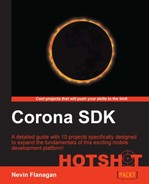No game like this is complete without an awe-inspiring boss craft or base that offers a more complex fight. Because boss crafts don't typically fly around in circles, a new action is called for in plan.lua; hover. It's very similar to turn in its implementation, so we won't cover it in too much detail.
First, open plan.lua and add the hover function to the environment:
self.Speed = speed end function actions.hover(xMove, yMove, duration) duration = duration * 1000 local start = system.getTimer() while duration > 0 do local elapsed = coroutine.yield() elapsed, start = elapsed.time - start, elapsed.time local fraction = math.min(1, (elapsed / duration)) local xDrift, yDrift = xMove * fraction, yMove * fraction xMove, yMove = xMove - xDrift, yMove - yDrift self.x, self.y = self.x + xDrift, self.y + yDrift duration = duration - elapsed end end function actions.turn(angle, duration) duration = duration * 1000
Now that the AI script actions are complete, we'll create the file that will accept these actions and advance the game when a boss is destroyed. Make a copy of dogfighter.lua in the top level of the project and name it boss.lua. The following are the steps to create a boss object:
- The
modulefunction will accept a flightplanfunction like thedogfightermodule does, but also accepts a function that dictates what will happen when the boss is defeated:return function (game, x, y, path, advance) local self = ship.dreadnought(game, game.Mobs.Air, enemyFilter)
- Record the
advancefunction in the boss's table so that we can retrieve it and run it when the boss dies:self.Speed = 0 self.Advance = advance local plan = require "plan" (self, path)
Using a supplied function gives us choices about how bosses appear. For instance, you could make a level where a boss appeared halfway through, and its defeat started a new schedule to proceed through the rest of the level.
In order for the schedule to be able to spawn a new boss object, the game's spawn table needs a reference to the module. Open game.lua and add a new line to the table near the top of the file.
scene.Spawn = {
turret = require "turret";
dogfighter = require "dogfighter";
boss = require "boss";
}To launch the boss at the end of the level, we'll modify the level schedule. Open marsh-enemies.lua and find the end of the function being passed to the schedule.
- We'll add an entry a second or two before the schedule runs out to create the
bossobject:at (58) spawn.boss(160, -40, orbit(), bossOneDestroyed) end ) return duration - Because it's easy in this case, we'll specify what happens when the boss is defeated first:
end local function bossOneDestroyed(self, game) game:dispatchEvent{name = 'Game'; action = 'ended', outcome = 'won'} end return function(game)
- Then we'll create a function that returns a set of flight orders moving in a figure-eight pattern; first, the boss will move down from its spawning point at the top of the screen and slide over to one corner of its loop:
local function orbit() return function() hover(0, 100, 2) after (1.5) hover(55, 0, 1.5) end end local function bossOneDestroyed(self, game)
- Then, its flight plan will go into a loop that will last until it is destroyed, moving down, then up and over, and then the same on the other side.
return function() hover(0, 100, 2) after (1.5) hover(55, 0, 1.5) while true do after(1) hover(40, 50, 1.5) after(1) hover(-150, -50, 4) after(1) hover(-40, 50, 1.5) after(1) hover(150, -50, 4) end end - As the boss moves, it will switch some of its guns on and off as it changes direction. Because these calls are repetitive, the flight plan can define reusable functions for them.
after (1.5) hover(55, 0, 1.5) local function crossFan() fire(1, 50, 80); fire(2, 50, -80) release(3); release(4) fire(5, 50, 13); fire(6, 50, -13) end local function focusForward() release(1); release(2) fire(3, 48, -15); fire(4, 48, 15) release(5); release(6) end while true do
- Once it calls those functions appropriately, the flight plan is complete.
while true do focusForward() after(1) hover(40, 50, 1.5) crossFan() after(1) hover(-150, -50, 4) focusForward() after(1) hover(-40, 50, 1.5) crossFan() after(1) hover(150, -50, 4) end
The default onDestroy handler falls short in two regards where the boss is concerned. It needs to end the level (as determined by the boss's advance function), and frankly, one little explosion isn't impressive enough for a boss's victory. The following are the steps to handle the boss's defeat:
- Open
ship.luaand frame in anonDestroyoverride for thedreadnoughtentry:dreadnought = ship { sprite = chassis [4]; MaxHealth = 1000; onDestroy = function(game, event) local self = event.unit end; Weapons = { - Most of the functions are still the same as the default
onDestroyfunction, so we'll start by bringing them in. However, we'll hold off on removing thebosssprite as shown in the following code:onDestroy = function(game, event) local self = event.unit timer.cancel(self.Guidance) for id, weapon in pairs(self.Weapons) do weapon:stop() end end - First, we'll start a repeating timer to set off explosions continuously on top of the
bosssprite:local w, h = self.width / 2, self.height / 2 local chainReaction = timer.performWithDelay(100, function(event) explosion(self.parent, self.xOrigin + math.random(-w, w), self.yOrigin + math.random(-h, h)) end, 0 )
- Then, we'll start a one-use timer that will clean things up. It will stop the endless explosions, remove the boss, and trigger the boss's
Advancefunction.self.Destruction = timer.performWithDelay(1000, function(event) timer.cancel(chainReaction) self:Advance(game) self:removeSelf() end )
Test things out! Once you make it past the other enemies and dodge the boss's guns, you'll see the boss going down in a blaze of glory. Having your character be invulnerable during development makes things like this much easier to test out.
We expanded the selection of actions available to the enemy's AI code. We created a new object type with a continuously repeating set of controls and internal logic to its actions. We also used one timer to regulate another, in order to create a visually interesting effect with a fixed duration.
